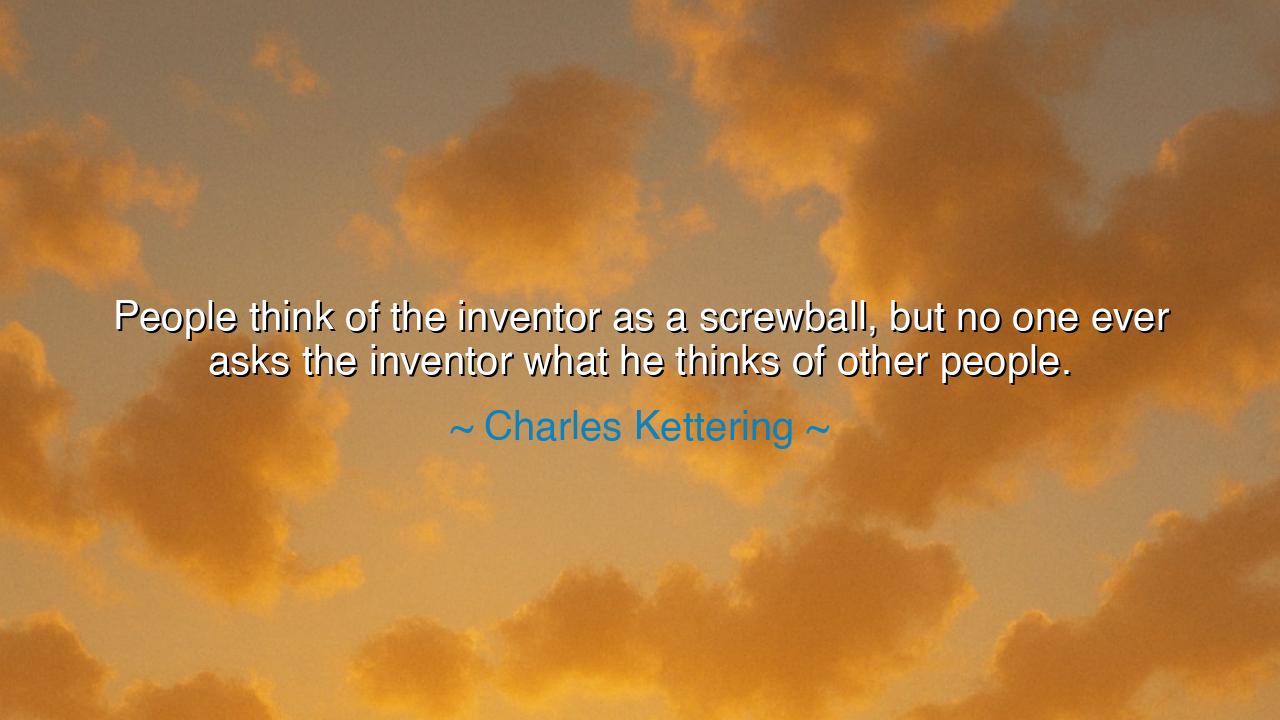
People think of the inventor as a screwball, but no one ever asks
People think of the inventor as a screwball, but no one ever asks the inventor what he thinks of other people.






"People think of the inventor as a screwball, but no one ever asks the inventor what he thinks of other people." These words from Charles Kettering offer a piercing critique of how society views creativity and innovation. The inventor, in the eyes of the public, is often seen as an eccentric, a dreamer whose ideas are too wild or too far out of reach for the practical world to accept. Yet, Kettering’s insight challenges this perception, turning the gaze back on society itself. He suggests that while the world readily dismisses the inventor as a "screwball", it rarely pauses to ask the inventor about their thoughts on those who reject them. This quote speaks to the alienation that inventors, creators, and pioneers often feel in a world that is slow to embrace new ideas, and to the misunderstanding that often accompanies innovation.
In the ancient world, the great philosophers and scientists often faced similar rejection. Socrates, for example, was seen by many in Athens as a troublemaker, a man whose relentless questioning of authority and tradition unsettled the social order. His way of thinking, which would eventually be seen as the foundation of Western philosophy, was dismissed by many as disruptive and nonsensical. Socrates was, in the eyes of many, a "screwball" who challenged everything people held to be true. And yet, he never hesitated to speak his mind, to question, and to push for a deeper understanding of life. In the end, he paid the ultimate price for his views, but it was through his vision and unwavering conviction that a new era of thought was born. Similarly, Kettering’s words remind us that inventors, like Socrates, often carry a vision that others cannot yet see, and thus they are frequently misunderstood by the world around them.
Consider the example of Nikola Tesla, a man whose contributions to electricity and technology revolutionized the world, yet whose ideas were often dismissed and belittled during his lifetime. Tesla, much like the inventor Kettering speaks of, was viewed as eccentric, even mad, by many of his contemporaries. His ideas were too advanced, too unconventional for the time. Yet, Tesla did not falter in the face of rejection. He continued to believe in the power of his inventions, trusting that history would ultimately vindicate him. Indeed, it is now widely recognized that Tesla’s ideas and inventions were foundational to the development of the modern world. In this way, Kettering’s words ring true: while society may dismiss the inventor in the moment, the inventor’s perspective is often far ahead of the world’s understanding.
Kettering’s quote also speaks to the relationship between creativity and society—how the act of creation is often an isolating endeavor. The inventor, in his search for new possibilities, may find himself in opposition to the norms, the comforts, and the expectations of his time. Thomas Edison, a close contemporary of Kettering, was no stranger to this dynamic. Edison’s relentless pursuit of innovation—from the invention of the light bulb to the development of the phonograph—often made him a target for criticism and ridicule. Yet, he continued to push forward, not out of vanity, but out of a deep belief in the potential of his work to change the world. Like Kettering’s quote suggests, Edison was more interested in his vision than in what others thought of him. In this way, the inventor’s true challenge lies not in the world’s perception of him, but in his commitment to his own ideas.
The crux of Kettering’s wisdom lies in the perseverance of the innovator. It is easy for society to dismiss what it does not understand, but the true measure of an inventor is not how the world views him in the moment, but in how steadfastly he continues his work. The lesson here is that creativity and vision often take time to be recognized and appreciated. The path of innovation is not always an easy one. It is fraught with rejection, misunderstanding, and even ridicule. But the true inventor, the true visionary, does not seek validation from the masses; he seeks only the fulfillment of his vision. Kettering’s words remind us that the value of innovation lies not in the immediate praise it receives, but in the courage to continue pushing forward despite resistance.
In our own lives, we must take Kettering’s words to heart. How often do we dismiss new ideas or innovations because they do not align with what we already know? How often do we see those who challenge the status quo as eccentric or unreasonable? The lesson is clear: we must strive to keep an open mind, to embrace the new and the unknown, and to understand that creativity often comes in forms that are initially difficult to comprehend. Just as the world once dismissed Edison, Tesla, and Socrates, we too must recognize that true innovation requires both the courage to create and the patience to wait for others to catch up.
Thus, let us remember the inventor, not just as a "screwball" but as the visionary who dares to see what others cannot. Let us celebrate those who challenge the status quo, who push the boundaries of possibility, and who are willing to be misunderstood in order to bring about the changes that shape our world. For in the end, it is the inventor’s courage and determination that will lead us toward a future filled with progress, even if we cannot always see the path clearly in the moment.






AAdministratorAdministrator
Welcome, honored guests. Please leave a comment, we will respond soon